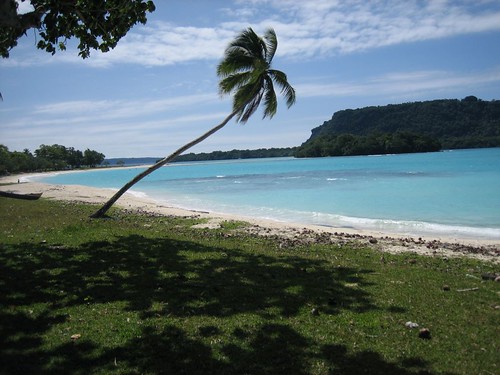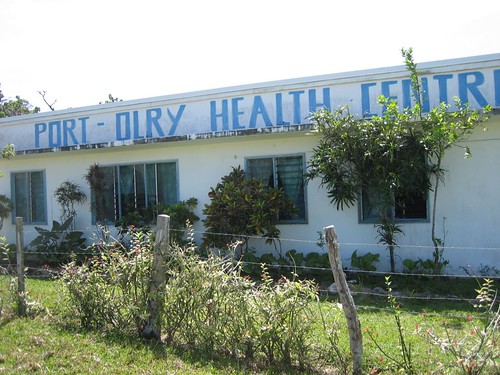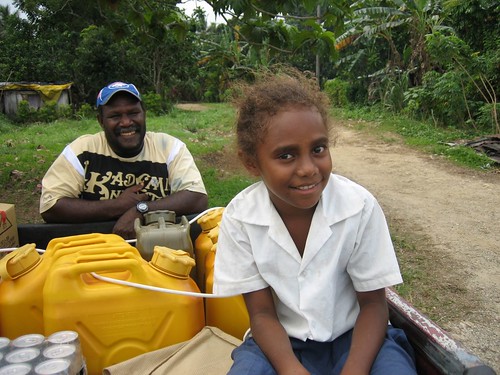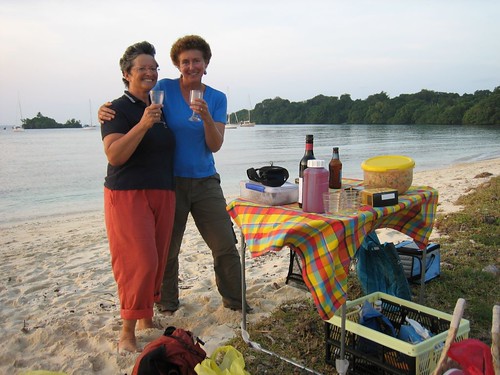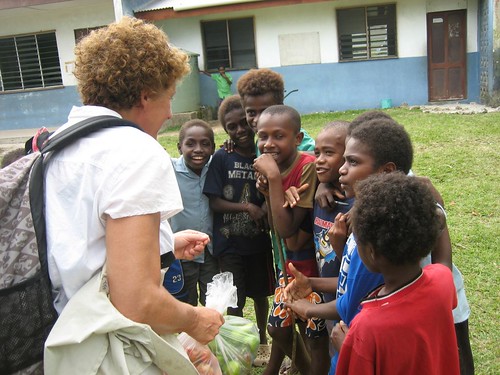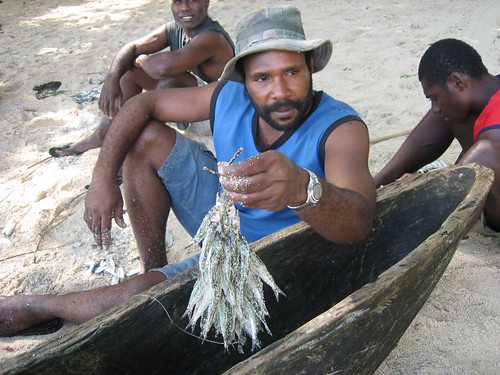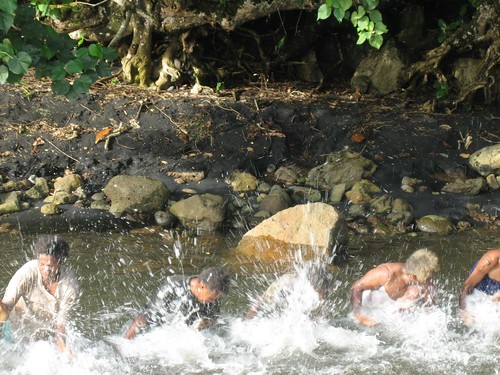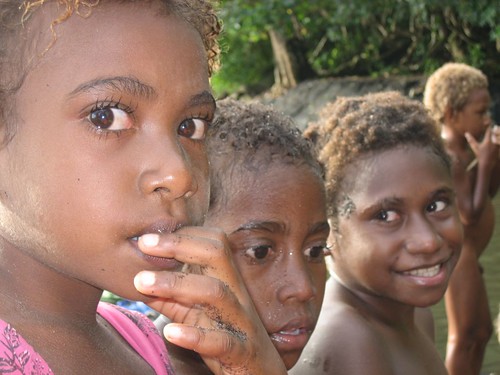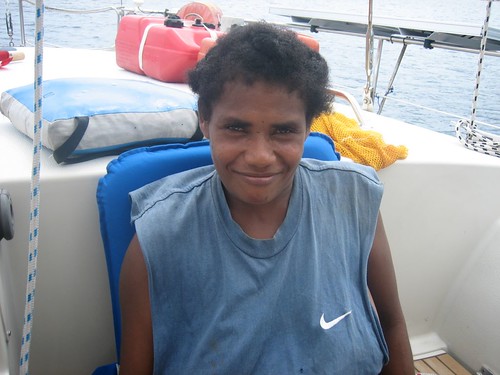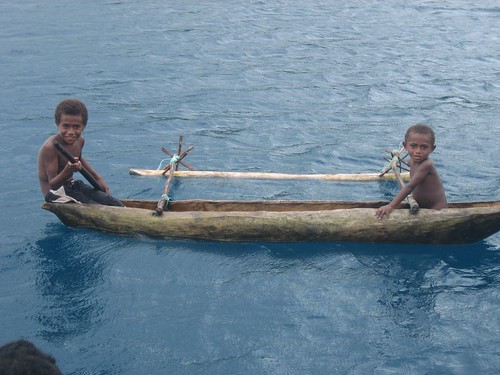We had a great time in Asanvari Bay, Maewo. We arrived there on Monday, August 24, and had a fun time catching up with 3 very special boats – all people we like very much and have known for some time now. They all had to leave on Tuesday morning, but there were a dozen other boats in the anchorage that were part of the Island Cruising Association Rally of New Zealand. We got to know a lot of them over the next few days, and were included in all of the ICA rally events. There were a lot of really nice people there – a good mix of boats from the U.S., Australia and New Zealand for the most part. We know the leader of the ICA from last year, and he (John) and his wife Lynn are extremely friendly and outgoing people. They arranged for a lot of “events” between the yachties and the locals. Normally we enjoy doing this ourselves, but it was a nice change to be part of a group.
The village of Asanvari is well known among yachties because of its extroverted chief, Chief Nelson, and his very charmismatic son, Nixon. The whole village was in mourning, however, because of a terrible tragedy that had just occurred two weeks before we arrived – the death of one of Chief Nelson’s sons. It was apparently the third of his sons to have died. They say it is all due to “black magic”. It was so sad, and somewhat awkward, to be there as a tourist at such a time. Somehow, however, the village still wanted to continue with many of the planned festivities between the yachts and themselves. I think they count on this annual visit for a fair portion of their income and perhaps they could not afford to forgo it.
It sounds a bit corny, but the ICA arranged with Chief Nelson to have a little ceremony on Wednesday where each boat was officially adopted by a village family. The families came dressed in their best outfits and presented us all with gifts of fruit and weavings, and even dresses for some of the women – a consistenly unflattering dress called the “mother hubbard” that was introduced to the islands by the missionaries a hundred and fifty years ago. The yachties all brought gifts to their adopted families over the next few days and got to know each other. Our “family” consisted of a husband and wife (Maurice and Katherine) and their children – we were never sure exactly how many children they had, but we did get to know their 12 year old girl Meery, and their 25 year old son, Paul a bit. Meery and her friend Violet accompanied us on a hike up to the top of the hill overlooking their village, and over the top of the beautiful waterfall that flows down to the sea. Meery and Violet were barefoot while Mark and I trudged along, slipping on the rocks, even in our hiking boots. We sang songs to each other and had a wonderful time.
The next day there was supposed to be a dance put on by the locals – a kustom dance – with traditional costumes and very primitive instruments. The young men who usually dance were mourning the death of their friend and did not dance. Only 2 adults and 3 young boys danced – and only for a few minutes. Then they made us a feast – consisting primarily of a very large, and very well cooked pig that they had killed that day. The pig was roasted in the ground for the entire day. Mark and I had actually heard the poor guy squealing his head off just before they disposed of him earlier in the day. I am not too keen on pig – particularly large boars with their heads intact – so I just filled up mainly on rice and some vegetables that were also served. Everyone else was pretty happy about the pig meal. The village arranged for a local “string band” to play and the yachties and the village kids spent a very enjoyable evening dancing together. They offered kava to everyone as well but after trying a cup of the very potent brew the first night, most of us declined altogether on night two.
Besides the village activities, Mark and I spent a lot of time snorkeling there. The water was about the clearest we have seen in Vanuatu and had some beautiful crevasses carved out in the rock by underground springs. The boat was sitting in about 60 feet of water and you could see to the bottom as if it were just a few feet deep.
We decided to leave on Thursday evening as we have to start heading back to Port Villa – which is about 150 miles to the south – and we saw that the winds were right to make at least the first leg of the trip – as far as Epi – an island about halfway between Asanvari and Port Villa. We left at 5:00 p.m. – on an amazingly beautiful evening – and as we sailed away from the island of Maewo, where Asanvari is located, we could understand why some people consider it one of the most beautiful places in Vanuatu. We had a great sail, going past the island of Pentecost and then past Ambrym whose active volcano was clearly visible belching up lava during the night. Mark was on watch and said it was beautiful (I was down below trying to get some sleep). In the morning we sailed into our current bay – on the southern part of Epi. It is a black sand bay, but the water is crystal clear. We thought we would just stay one night, but now we are ending our second day here and will probably stay a third. It is quite lovely. Three guys from the village nearby paddled over today and asked to see our boat. We had them on-board and had an interesting time talking with them. Once again, we received fruit in exchange for clothing and other goods. We had a little train set on board which we gave them for their kids and they were thrilled.
Our big activity today was changing our sails – we had to take down the large genoa and put up our much smaller blade jib. It is not a bad job, except once you take the sail down, you have to fold it up on the deck and put it away. It is so big and so bulky that it seems impossible to do. Leon and Ricky once helped us do this when we were together in the Caribbean, so they can understand how hard it is. Somehow we managed to do it however, having a good schvitz in the mid-day sun, and now have the correct sail for heading south.
L.

